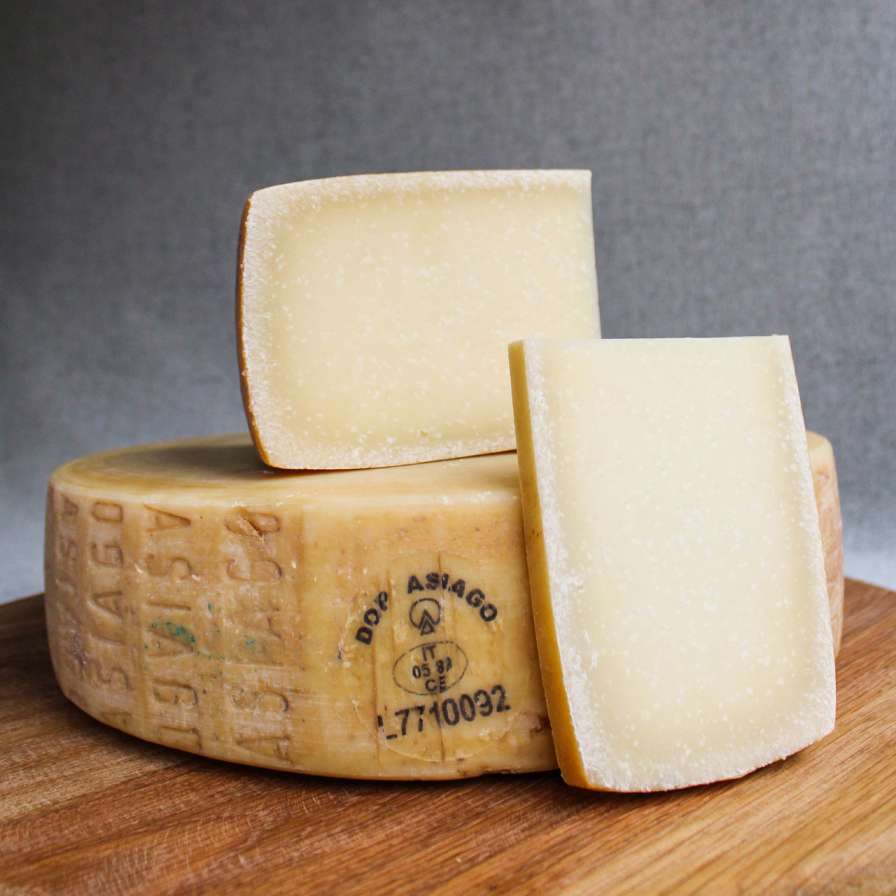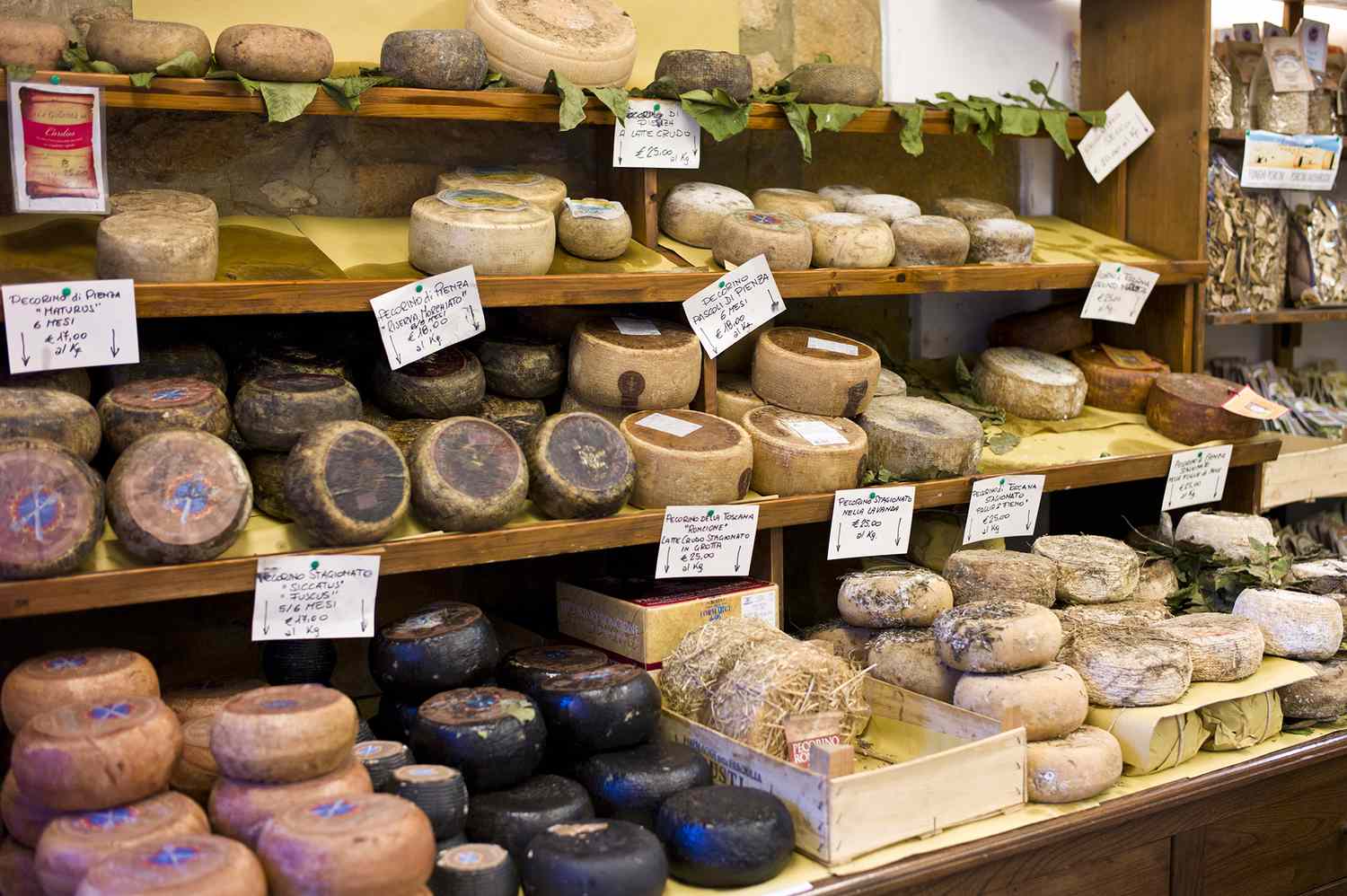Asiago Cheese Overview

Asiago cheese is a popular Italian cheese made from cow’s milk. It is a versatile cheese that can be enjoyed both fresh and aged. Fresh Asiago cheese has a semi-soft texture and a mild, buttery flavor. As it ages for nine months or longer, the cheese becomes firmer and develops a sharper, nuttier taste. Asiago cheese is often used in a variety of dishes, such as pasta, pizza, and salads. Its distinct flavor and creamy texture make it a favorite among cheese lovers.
Asiago Cheese Origins And Varieties
Asiago cheese has its origins in the Asiago Plateau located in the Veneto region of Northern Italy. The cheese has a protected designation of origin (PDO) status, meaning it can only be produced in specific provinces within this region.
Asiago cheese comes in two main varieties: fresh Asiago (Asiago Pressato) and aged Asiago (Asiago d’Allevo). Fresh Asiago is creamy and mild in flavor, while aged Asiago is firmer with a sharper, nuttier taste. Both varieties are versatile and can be used in a variety of dishes, adding a unique Italian flavor to any recipe.
Asiago Cheese Flavor And Texture
Asiago cheese is known for its unique flavor and texture. The flavor of Asiago cheese can vary depending on the age of the cheese. Fresh Asiago has a creamy and mild taste, similar to that of a young Parmesan. As Asiago ages, it develops a sharper and nuttier flavor, making it more suitable for grating and adding complexity to recipes.
In terms of texture, fresh Asiago is soft and smooth, while aged Asiago becomes firmer and crumbly. The texture of aged Asiago allows it to be easily grated or shaved over dishes, adding a delightful crunch and enhancing the overall dining experience.
Parmesan Cheese Overview

Parmesan cheese, also known as Parmigiano-Reggiano, is a hard, granular cheese that originated in Italy. It is made from cow’s milk and has a distinctively intense and pungent flavor. Parmesan cheese is produced using a traditional aging process that lasts for at least 12 months, resulting in a hard and crumbly texture. This cheese is highly regarded for its nutty and savory taste, which adds depth to various dishes. Parmesan cheese is commonly grated over pasta, salads, and soups, or used as a key ingredient in recipes like risotto and pesto sauce.
Parmesan Cheese Production And Aging Process
Parmesan cheese is produced using a meticulous and traditional process in Italy. The production begins with milking cows and collecting the fresh milk. After that, the milk is heated and bacteria, along with rennet, is added to coagulate it. The curd is then cut into small pieces and heated again. The resulting curds are pressed into molds and left to drain out whey. The formed wheels are then salted and aged for at least 12 months. During the aging process, the cheese develops its distinct flavor and crumbly texture. The longer the cheese ages, the more complex and intense its flavor becomes.
Parmesan Cheese Flavor And Usage
Parmesan cheese is known for its intense and pungent flavor. It has a rich, nutty, and slightly fruity taste that develops during the aging process. The cheese has a complex and distinctive aroma that adds depth to any dish. Parmesan is most commonly used as a topping for pasta dishes, soups, and salads. It is also a popular ingredient in sauces, risottos, and marinades. The cheese’s crumbly texture makes it ideal for grating, allowing it to be easily sprinkled over dishes for added flavor. Parmesan is a versatile cheese that enhances the taste of various culinary creations.
Asiago Vs Parmesan: Nutritional Value

When comparing the nutritional value of Asiago and Parmesan cheese, there are some notable differences. Parmesan cheese is higher in protein, calcium, and phosphorus compared to Asiago cheese. It also contains less sodium and sugar per serving. On the other hand, Asiago cheese tends to have fewer calories, total fat, and saturated fat than Parmesan cheese. These nutritional differences can be helpful in making an informed decision when choosing between the two cheeses. It’s important to consider your specific dietary needs and preferences when selecting the cheese that suits you best.
Nutritional Content Of Asiago Cheese
Asiago cheese is known for its rich, nutty flavor and creamy texture. In terms of nutritional content, Asiago cheese is lower in calories, total fat, and saturated fat compared to Parmesan cheese. It is also a good source of protein, calcium, and phosphorus. A 1-ounce serving of Asiago cheese contains approximately 110 calories, 7 grams of fat, 4.5 grams of saturated fat, 6 grams of protein, and 10% of the recommended daily intake of calcium. It is important to note that the exact nutritional values may vary depending on the specific brand and variety of Asiago cheese.
Nutritional Content Of Parmesan Cheese
Parmesan cheese is known for its rich, nutty flavor and firm texture. In terms of nutritional content, Parmesan cheese is higher in calories, total fat, and saturated fat compared to Asiago cheese. A 1-ounce serving of Parmesan cheese contains approximately 120 calories, 8 grams of fat, 5 grams of saturated fat, 10 grams of protein, and 35% of the recommended daily intake of calcium. It is also a good source of phosphorus. It is important to note that the exact nutritional values may vary depending on the specific brand and variety of Parmesan cheese.
Cooking With Asiago And Parmesan

Asiago and Parmesan cheese are both versatile ingredients that can elevate the flavor of various dishes. Here are some suggestions on how to use these cheeses in your cooking:
- Asiago Cheese:
- Grated Asiago can be sprinkled over pasta dishes, salads, or soups for a nutty and flavorful kick.
- Melted Asiago is great for sauces, fondues, and risottos, adding a creamy and rich taste.
- Asiago can also be used in sandwiches, pizzas, and quiches for a savory twist.
- Parmesan Cheese:
- Parmesan is best known for grating over pasta, adding a salty and savory element.
- It can also be used as a crust for meats like chicken or pork, providing a crispy and flavorful coating.
- Parmesan shavings can enhance the taste of salads, roasted vegetables, and even popcorn.
Both Asiago and Parmesan cheeses can be enjoyed on their own or as part of a delicious recipe, enhancing the overall flavor and texture of the dish.
Best Dishes To Use Asiago Cheese
Asiago cheese adds a delightful and nutty flavor to various dishes, making it a versatile ingredient in the kitchen. Here are some of the best dishes to use Asiago cheese:
- Pasta: Sprinkle grated Asiago over pasta dishes such as fettuccine Alfredo or spinach and mushroom pasta for a creamy and flavorful finish.
- Salads: Add shaved or crumbled Asiago to green salads or Caesar salads for a tangy and savory twist.
- Soups: Sprinkle grated Asiago on top of soups like tomato basil or broccoli cheddar for an extra layer of richness.
- Sandwiches: Incorporate slices of Asiago into sandwiches, paninis, or grilled cheese for a deliciously melty and nutty flavor.
These dishes are just a few examples of how Asiago cheese can enhance the overall taste and texture of your culinary creations.
Best Dishes To Use Parmesan Cheese
Parmesan cheese adds a bold and savory flavor to a variety of dishes, making it a versatile ingredient in the kitchen. Here are some of the best dishes to use Parmesan cheese:
- Pasta: Sprinkle grated Parmesan over classic dishes like spaghetti carbonara or pesto pasta for a cheesy and nutty bite.
- Risotto: Use Parmesan to finish off a creamy and comforting risotto, adding depth and richness to each spoonful.
- Salads: Add shaved or grated Parmesan to salads like Caesar or Caprese for a sharp and tangy kick.
- Soups: Sprinkle grated Parmesan on top of soups such as minestrone or tomato basil for an extra layer of flavor.
Incorporating Parmesan cheese into these dishes will elevate their taste and bring a touch of Italian flair to your meals.
Tasting Notes: Asiago Vs Parmesan

When it comes to tasting notes, both Asiago and Parmesan offer unique flavors that can enhance a variety of dishes. Asiago cheese has a nutty and creamy flavor with subtle hints of sweetness. As it ages, the flavor becomes sharper and more intense. On the other hand, Parmesan cheese has a bold and intense flavor with a unique combination of savory and tangy notes. Its crumbly texture allows it to melt in your mouth, releasing its rich and complex flavors. Whether you choose Asiago or Parmesan, you can expect a delightful culinary experience.
Flavor Profiles Of Asiago And Parmesan
Asiago cheese offers a delightful flavor profile that is slightly buttery, creamy, and nutty. Its taste evolves as it ages, becoming sharper and more intense with a noticeable bitterness, especially in Asiago Stravecchio. On the other hand, Parmesan cheese is known for its robust and sharp flavor. It has a distinct earthiness, along with well-expressed fruity and savory notes. Parmigiano Reggiano, particularly when fully aged, exhibits traits characteristic of umami flavor. Both Asiago and Parmesan bring unique and delicious flavors to dishes, making them versatile choices for culinary creations.
Pairing Suggestions For Asiago And Parmesan
When it comes to pairing Asiago and Parmesan cheeses, there are plenty of delicious options to explore. Here are some suggested pairings for each cheese:
- Asiago:
- Pair with cured meats like prosciutto or salami for a delightful charcuterie board.
- Enhance the flavors of roasted vegetables by grating Asiago over the top before serving.
- Enjoy with fresh fruits like apples or pears for a sweet and savory combination.
- Sprinkle Asiago over pasta dishes or risottos for an extra burst of flavor.
- Parmesan:
- Shave Parmesan onto a fresh green salad for added richness and depth.
- Pair with a glass of Chianti or other red wine to complement the cheese’s savory profile.
- Use Parmesan as a topping for homemade pizzas or savory tart recipes.
- Add grated Parmesan to creamy soups or sauces for a bold and cheesy taste.
Experiment with these pairing suggestions to create memorable culinary experiences with both Asiago and Parmesan cheeses.
Conclusion

In conclusion, when comparing Asiago cheese and Parmesan cheese, it’s clear that they each have their own unique characteristics and flavors. Parmesan is known for its nutty and savory taste, while Asiago has a milder flavor profile. Both cheeses are versatile and can be used in various dishes, from pasta to salads. Ultimately, the choice between Asiago and Parmesan comes down to personal preference and the specific flavor profiles desired in a dish. Whether you prefer the boldness of Parmesan or the subtlety of Asiago, these Italian cheeses are sure to elevate any culinary creation.
Key Differences Between Asiago And Parmesan
The key differences between Asiago and Parmesan cheese lie in their flavor profiles and production methods.
- Flavor: Asiago cheese has a nuttier and creamier flavor that becomes sharper as it ages, while Parmesan cheese has a more intense and pungent flavor.
- Texture: Asiago cheese has a texture that can range from smooth to crumbly, depending on its age. Parmesan cheese has a crumbly texture that makes it ideal for grating.
- Production: Asiago cheese is produced in the Asiago plateau in Italy, while Parmesan cheese is produced in the regions of Parma, Reggio Emilia, Modena, and Bologna.
Overall, the choice between Asiago and Parmesan depends on personal preference and the desired flavor profile for a dish.
Recommendations Based On Flavor Preferences
When it comes to flavor preferences, Asiago and Parmesan offer different experiences. If you prefer a more intense and pungent flavor, Parmesan is the way to go. Its strong and nutty taste adds a bold kick to dishes like pasta, risotto, and soups. On the other hand, if you prefer a milder and creamier flavor with a hint of tanginess, Asiago is the better choice. Its nutty and slightly sweet taste works well in salads, sandwiches, and as a topping for pizza. Consider your desired flavor profile and the dish you’re preparing to make the best choice between Asiago and Parmesan.
FAQ About Asiago Cheese Vs Parmesan: Comparing Italian Cheeses
Q: What is the main difference between Asiago and Parmesan cheese?
A: The main difference lies in the production process and aging. Asiago is made from cow’s milk and comes in two varieties – fresh (Asiago Pressato) and aged (Asiago d’allevo). Parmesan, on the other hand, is made from cow’s milk and only comes in one aged variety.
Q: Which cheese is more flavorful, Asiago or Parmesan?
A: Both cheeses have distinct flavors. Asiago is known for its nutty and slightly tangy taste, while Parmesan has a rich, salty, and savory flavor. The choice between the two depends on personal preference and the intended use in recipes.
Q: Can Asiago be used as a substitute for Parmesan and vice versa?
A: Yes, Asiago and Parmesan can often be used interchangeably in recipes. However, the flavor profiles may vary slightly, so it’s best to adjust according to taste. Parmesan tends to be sharper and saltier than Asiago.
Q: Which cheese is better for grating over pasta dishes, Asiago, or Parmesan?
A: Both Asiago and Parmesan are excellent choices for grating over pasta dishes. Parmesan is a classic choice for its strong flavor and ability to melt beautifully over pasta, while Asiago can add a unique nutty flavor to dishes.
Q: Do Asiago and Parmesan have different textures?
A: Yes, Asiago and Parmesan have distinct textures. Fresh Asiago is semi-soft and creamy, while aged Asiago becomes harder and crumbly. Parmesan, on the other hand, is known for its granular and gritty texture due to its long aging process.
Q: Are there any specific dishes where Asiago is preferred over Parmesan?
A: Asiago is often used in dishes like risottos, salads, and sandwiches where a milder flavor is desired. It pairs well with fruits, nuts, and cured meats. Parmesan, on the other hand, is a staple in Italian cuisine and is commonly used in pasta dishes, soups, and salads for its bold flavor.
Q: How should Asiago and Parmesan be stored to maintain freshness?
A: Both cheeses should be stored in the refrigerator in airtight containers or wrapped tightly in plastic wrap to prevent them from drying out. It’s best to keep them away from strong-smelling foods to prevent them from absorbing unwanted flavors.

We are introducing OH! NANA, where culinary excellence meets sustainability! Our journey began with a passion for creating delicious, nutrient-dense dishes while minimizing waste and environmental impact. At OH! NANA, we believe that great taste and nutritional value can go hand in hand with responsible sourcing and production. Our commitment to delivering intense flavors and high nutritional value is paired with a dedication to reducing waste in every aspect of our operations. From sourcing fresh, locally-grown ingredients to implementing efficient kitchen practices, we strive to positively impact both your health and the health of our planet.